Blank L., Tarquin A. Engineering Economy (McGraw-Hill Series in Industrial Engineering and Management)
Подождите немного. Документ загружается.

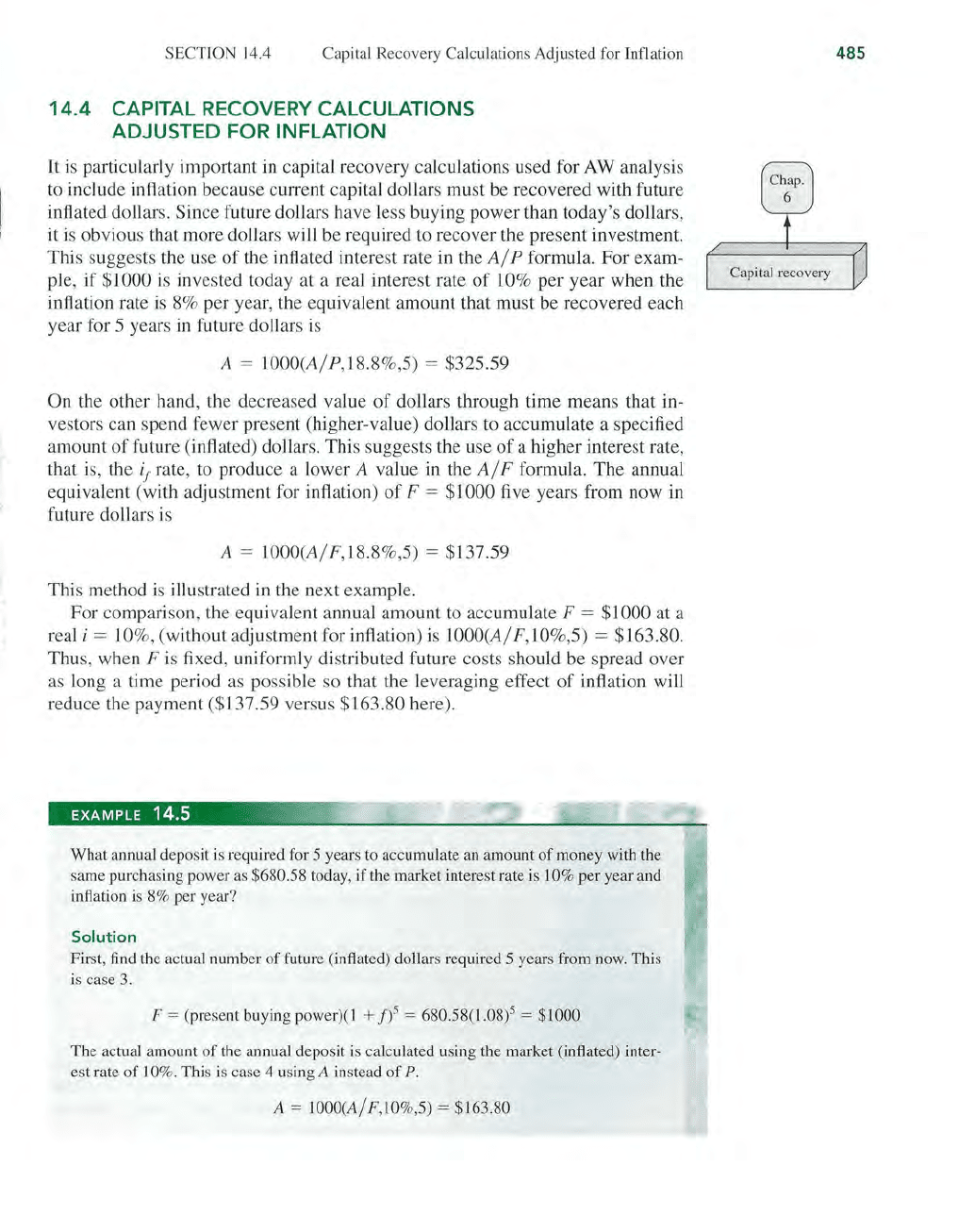
SECTION 14.4 Capital Recovery Calculations Adjusted for Inflation
14.4
CAPITAL RECOVERY CALCULATIONS
ADJUSTED FOR INFLATION
It
is particularly important in capital recovery calculations used for AW analysis
to include inflation because current capital dollars must
be
recovered with future
inflated dollars. Since future dollars have less buying power than today's dollars,
it is obvious that more dollars
wi
II
be required to recover the present investment.
This suggests the use
of
the inflated interest rate in the
A/
P formula.
For
exam-
ple,
if
$1000 is invested today at a real interest rate
of
10% per year when the
inflation rate is 8% per year, the equivalent amount that must be recovered each
year for 5 years
in
future dollars
is
A = 1
OOO(A/
P,
18.8%,5) = $325.59
On the other hand, the decreased value
of
dollars through time means that in-
vestors can spend fewer present (higher-value) dollars to accumulate a specified
amount
of
future (inflated) dollars. This suggests the use
of
a higher interest rate,
that is, the
if
rate, to produce a lower A value in the
A/
F formula. The annual
equivalent (with adjustment for inflation)
of
F = $1000 five years from now
in
future dollars
is
A =
1000(A/F,18.8%
,5) = $137.59
This method is illustrated
in
the next example.
For comparison, the equivalent annual amount to accumulate
F = $1000 at a
real
i = 10%, (without adjustment for inflation) is 1000(A/ F,1O%,5) = $163.80.
Thus, when F is fixed, uniformly distribut
ed
future costs should be spread over
as long a time period as possible so that the leveraging effect
of
inflation will
reduce the payment ($137.59 versus
$163.80 here).
EXAM PLE 14.5
",
What annual deposit is required for 5 years
to
accumulate an amount
of
money with the
same purchasing power as
$680.58 today, if the market interest rate
is
I 0%
per
year and
inflation is
8% per year?
Solution
First,
find
the actual number
of
future (inflated) dollars required 5 years from now. This
is
case
3.
F = (present buying power)(l +
f)5
= 680.58(1.0W = $1000
The actual amount
of
the annual deposit
is
calculated using the market (inflated) inter-
est rate
of
10
%.
This is case 4
us
ing A instead
of
P.
A =
1000(A/F
,10%,5) = $163.80
485
Capital
recovery
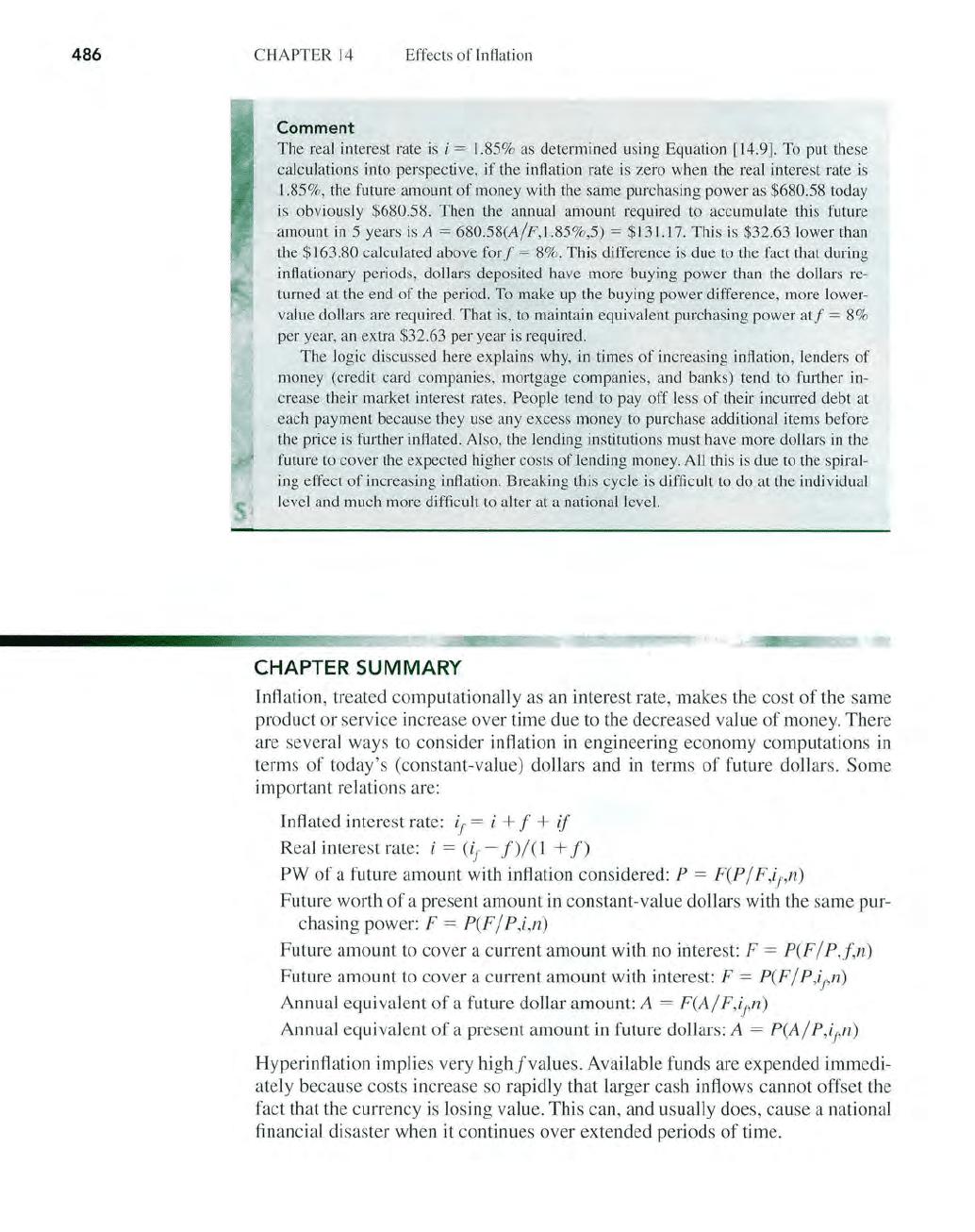
486
CHAPTER
14
Effects
of
Inflation
Comment
The real interest rate
is
i = l.85%
as
determined using Equation [14.9]. To put these
calculations into perspective, if the inflation rate
is
zero when the real interest rate
is
1.85%, the future amount
of
money with the same purchasing power
as
$680.58 today
is
obviously $680.58. Then the annual amount required to accumulate this future
amount
in
5 years is A = 680.58(AIF,
1.85%,5)
= $131.17. This
is
$32.63 lower than
the $163.80 calculated above
forf
=
8%
. This difference
is
due to the fact that during
inflationary periods, dollars deposited have more buying power than the dollars re-
turned at the end
of
the period. To make up the buying power difference, more lower-
value dollars are required. That is, to maintain equivalent purchasing power
atf
= 8%
per year, an extra $32.63 per year
is
required.
The logic discussed here explains why, in times
of
increasing inflation, lenders
of
money (credit card companies, mortgage companies, and banks) tend to further in-
crease their market interest rates. People tend to pay
otf
less
of
their incurred debt at
each payment because they use any excess money
to
purchase additional items before
the price is further inflated. Also, the lending institutions must have more dollars
in
the
future
to
cover the expected higher costs
of
lending money. All this is due
to
the spiral-
ing effect
of
increasing inflation. Breaking this cycle is difficult
to
do at the individual
level and much more difficult to alter at a national leveL
CHAPTER SUMMARY
Inflation, treated computationally as an interest rate, makes the cost
of
the same
product or service increase over time due to the decreased value
of
money. There
are several ways to consider inflation
in
engineering economy computations
in
terms
of
today's (constant-value) dollars and in terms
of
future dollars. Some
important relations are:
lnflated interest rate:
if = i + f + if
Real interest rate: i =
(i
f -
f)1(1
+
f)
PW
of
a future amount with inflation considered: P = F(P I F,if,n)
Future worth
of
a present amount in constant-value dollars with the same pur-
chasing power:
F =
P(F
I P,i,n)
Future amount to cover a current amount with no interest: F =
P(F
I P,f,n)
Future amount to cover a current amount with interest: F = P(F I P,ipn)
Annual equivalent
of
a future dollar amount: A = F(AI F,ipn)
Annual equivalent
of
a present amount in future dollars: A =
P(AI
P,ipn)
Hyperinflation implies very
highfvalues
. Available funds are expended immedi-
ately because costs increase so rapidly that larger cash inflows cannot offset the
fact
th
at the currency
is
losing value. This can, and usually does, cause a national
financial disaster when it continues over extended periods
of
time.
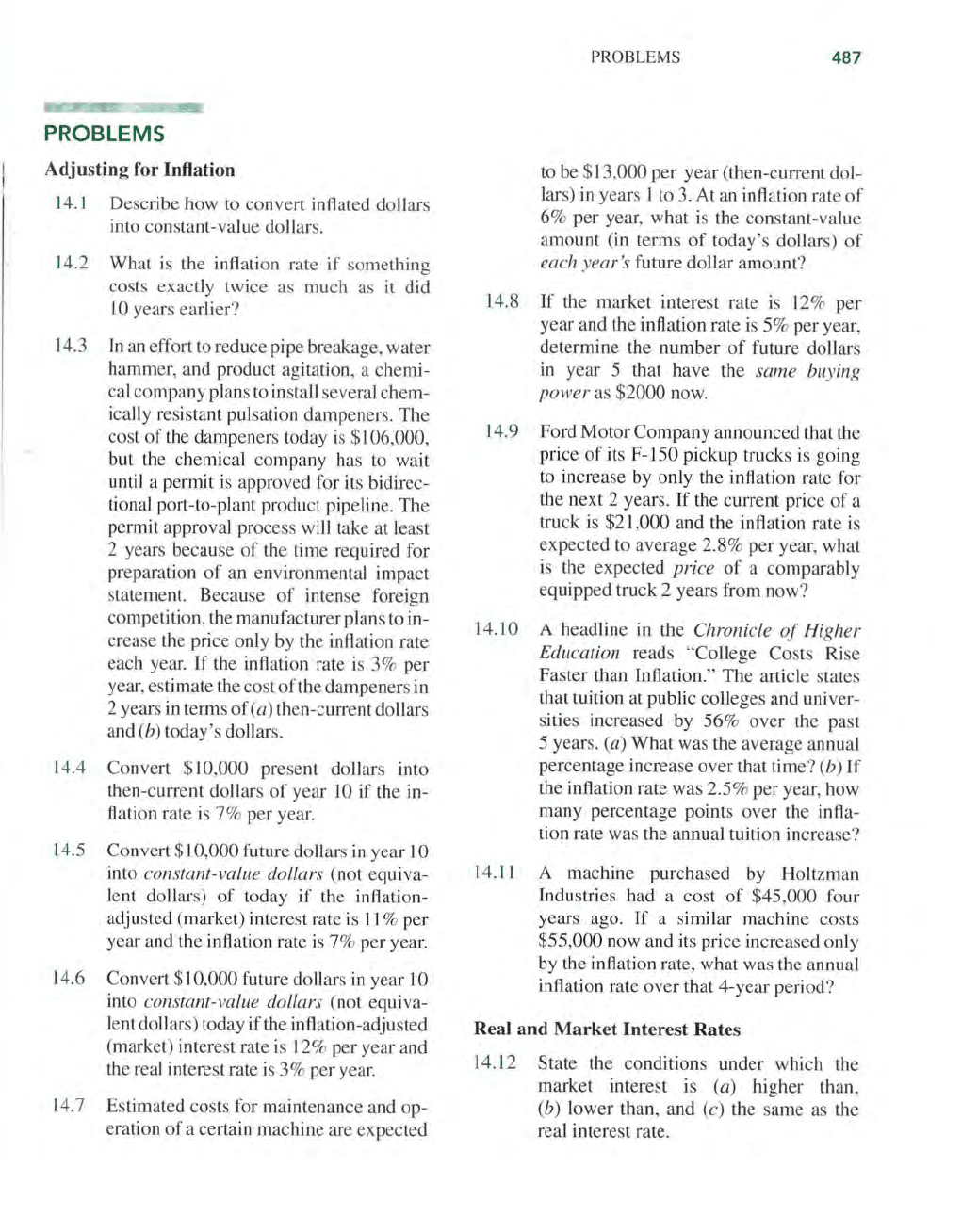
PROBLEMS
Adjusting for Intlation
14
.1
Describe how to convert
infl
ated do
ll
ars
into constant-value do
ll
ar
s.
14.2 What is the infla
ti
on rate if something
costs exac
tl
y twi
ce
as much as it did
1O
years
ea
rlier?
14.3 In an effort to reduce pipe breakage, wat
er
hamm
er
, and product agita
ti
on, a chemi-
cal
co
mpany plans to
in
sta
ll
several che
m-
ic
ally resistant pulsation dampener
s.
The
cost of the dampeners today is
$
10
6,000,
but the chemical company has to wait
until a permit is approved for its bidirec-
tional port-to-plant product pipeline. The
permit approval process will take at least
2 years because of the time required for
prepara
ti
on
of
an environmental impact
statemen
t.
Because
of
in
tense f
or
eign
competition, the manufacturer
pl
ans to in-
crease the price only by the
infl
ation rate
each yea
r.
If
the inflation rate is 3% per
year, estimate the cost
of
the dampeners
in
2 years
in
terms of (a) the
n-
current dollars
and
(b) toda
y's
doUar
s.
14.4 Convert $10,
000
pr
ese
nt do
ll
ars into
the
n-
current do
ll
ars of year
10
if the in-
fl
a
ti
on rate is 7% per yea
r.
14.5 Convert $ 1 0,
000
future dollars
in
year 10
into
constant-value dollars (not equiva-
lent do
ll
ars)
of
today if the
infl
ation-
adjusted (marke
t)
interest rate is J 1 % per
year and the inflation rate is 7% per year.
14.6 Convert
$1
0,000 future dollars
in
y
ea
r 10
into
co
nstant-
va
lu
e dollars (not equiva-
le
ntd
o
ll
ars) today if the infla
ti
on-adjusted
(market) interest rate is 12% per
yea
r and
the real
in
terest rate is 3% per year.
14
.7 Estimated costs f
or
m
ai
ntenance and op-
era
ti
on of a certain machine are expected
PROBLEMS
487
to be $13,
000
p
er
year (the
n-
current dol-
lars)
in
years 1 to 3. At an infla
ti
on rate
of
6% p
er
year, what is the constant-value
amount (in terms
of
today's do
ll
ars)
of
each year's future dollar amount?
14.8
If
the m
ar
ket interest rate is 12% per
year and the inflation rate is 5% per
yea
r,
determine the number of future do
ll
ars
in
year 5 that have the same buy
in
g
power
as $2000 now.
14.9 Ford
Mot
or Company announced that the
price
of
its F-150 pickup trucks is go
in
g
to increase by only the inflation rate for
the next 2 years.
If
the current price of a
truck is
$21,000 and the inflation rate is
expected to average 2.8% per year, what
is the expected
pr
ice
of
a compara
bl
y
equipped truck 2 years from n
ow?
14.1O A headline in the Chronicle
of
Higher
Education reads "Coll
ege
Costs
Ri
se
Faster than
Inflation."
The
article states
that tuition at public colleges and univer-
sities increased by 56% over the past
5
ye
ar
s. (a) What was the average annual
percentage increase over that time?
(b) If
the infla
ti
on rate
wa
s 2.5% per year, how
many percentage points
ove
r the infla-
tion rate was the annual tuition increase?
l4.11 A machine purchased by Holtzman
Industries had a cost
of
$45,
000
four
years ago.
If
a similar machine costs
$55,000 now and its price increased only
by the
infl
ation rate, what was the annual
inflation rate ov
er
that 4-year pe
ri
od?
Real and
Market
Interest Rates
14. 12
St
ate the conditions under w
hi
ch the
market interest is
(a)
hi
gh
er
than,
(b) lower than, and (c) the same as the
real interest rate.
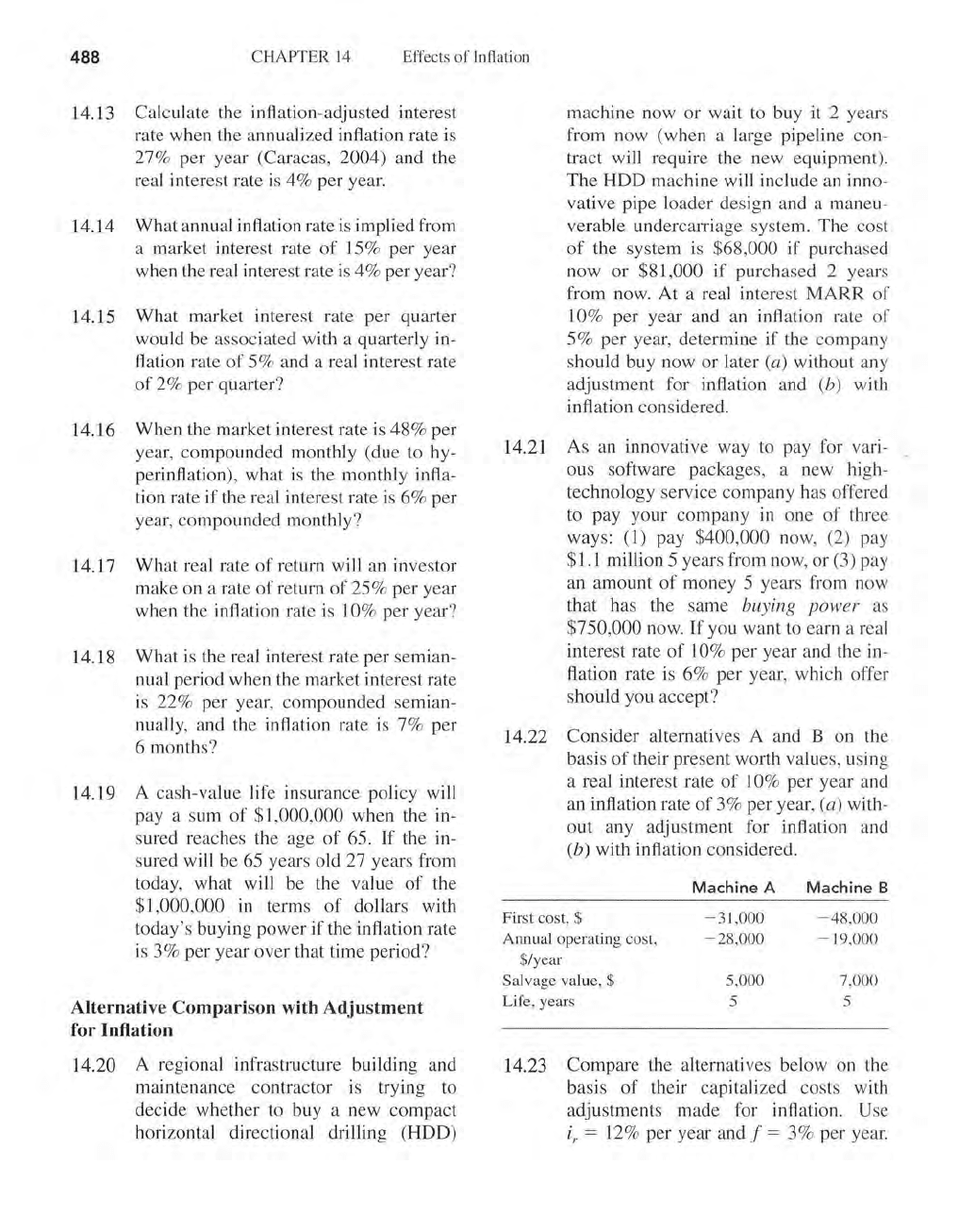
488
CHAPTER 14
Effects
of
Inflation
14.
13
Calculate the inflation-adjusted interest
rate when the annualized inflation rate is
27% per year (Caracas,
2004) and the
real interest rate is 4% per year.
14.14 What annual inflation rate is implied from
a market interest rate
of
15% per year
when the real interest rate is 4% per year?
14.
15
What market interest rate per quarter
would be associated with a quarterly in-
flation rate
of
5% and a real interest rate
of
2% per quarter?
14.16 When the market interest rate
is
48 % per
year, compounded monthly (due to hy-
perinflation), what is the monthly infla-
tion rate
if
the real interest rate is 6%
per
year, compounded monthly?
14.17 What real rate
of
return will an investor
make on a rate
of
return
of
25% per year
when the inflation rate
is
10% per year?
14.
18
What is the real interest rate per semian-
nual period when the market interest rate
is 22% per year, compounded semian-
nually, and the inflation rate
is
7%
per
6 months?
14.
19
A cash-value life insurance policy will
pay a sum
of
$1
,000,000 when the in-
sured reaches the age
of
65.
If
the in-
sured will be 65 years old 27 years from
today, what will be the value
of
the
$1
,000,000
in
terms
of
dollars with
today's buying power
if
the inflation rate
is
3% per year over that time period?
Alternative Comparison with Adjustment
for Inflation
14.20 A regional infrastructure building and
maintenance contractor is trying to
decide whether to buy a new compact
horizontal directional drilling (HDD)
machine now
or
wait to buy it 2 years
from now (when a large pipeline con-
tract will require the new equipment).
The
HDD machine will include an inno-
vative pipe loader design and a maneu-
verable undercarriage system.
The
cost
of
the system
is
$68,000 if purchased
now or
$81,000 if purchased 2 years
from now. At a real interest
MARR
of
10% per year and an inflation rate
of
5% per year, determine
if
the company
should buy now or later
(a) without any
adjustment for inflation and
(b)
wi
th
inflation considered.
14.
21
As
an
innovative way to pay for vari-
ous software packages, a new high-
technology service company has offered
to pay your company in one
of
three
ways:
(1) pay $400,000 now, (2) pay
$1.1 million 5 years from now, or (3) pay
an amount
of
money 5 years from now
that has the same
buying
pow
er as
$750,000 now.
If
you want to earn a real
interest rate
of
10% per year and the in-
flation rate
is 6% per year, which offer
should you accept?
14.22 Consider alternatives A and B on the
basis
of
their present worth values, us
in
g
a real interest rate
of
10%
per
year and
an inflation rate
of
3% per year, (a) with-
out
any adjustment for inflation and
(b) with inflation considered.
First cost, $
Annual operating cost,
$/year
Salvage value, $
Life, years
Machine A
-
31
,000
-
28
,000
5,000
5
Machine B
- 48,000
-
19
,000
7,000
5
14.23 Compare the alternatives below on the
basis
of
their capitalized costs with
adjustments made for inflation.
Use
ir
= 12% per year and f = 3% per year.
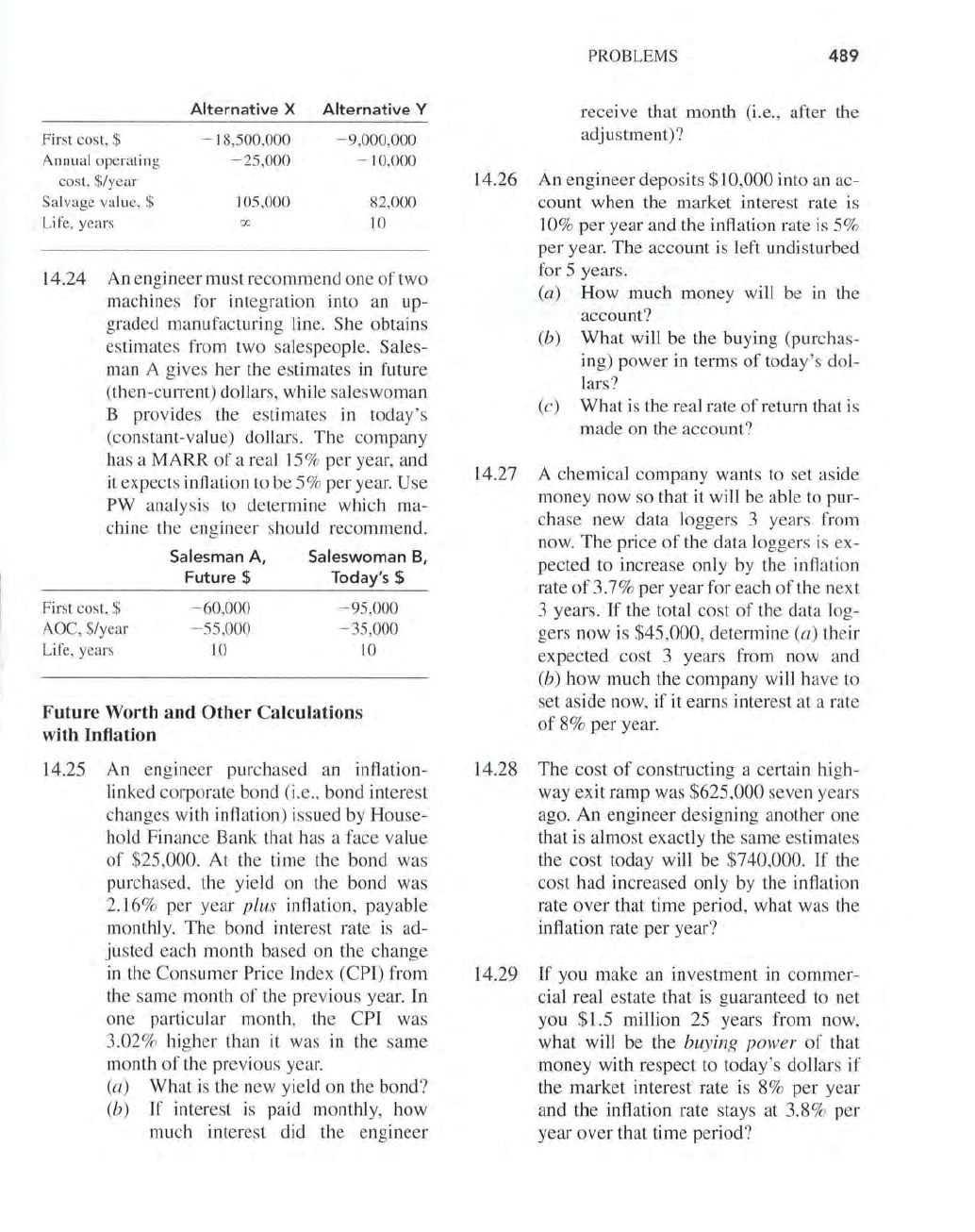
Alternative
X
Alternative
Y
Fi
rst cost, $ -
18
,500,000
- 9,000,000
Annual operating -
25
,000 -
10
,000
cost, $/y
ea
r
Salvage value, $
105,000
82
,000
Life, years
00
10
14.24 An engineer
must
recomm
end
on
e of
two
machines for
int
egration into an up-
graded
manufacturin
g line.
She
obtains
estimates f
rom
two salespeople. Sales-
man A
give
s
her
the estimates
in
future
(then-current) dollars, while
sale
s
woman
B
provide
s the
estimat
es
in
today
's
(constant-value)
dollar
s.
Th
e
company
has
a
MARR
of
a real I 5 %
per
year, and
it expects inflation to be 5%
per
year.
Use
PW
analysis to determjne which ma-
chine the
engineer
should recommend.
First cost, $
AO
e,
$/year
Life, years
Salesman
A,
Future
$
- 60,000
-
55
,000
10
Saleswoman
B,
Today's $
-
95
,000
- 35,000
10
Future Worth and Other Calculations
with Inflation
14.25 An
engineer
purcha
se
d an inflation-
linked
corporate
bond (i. e.,
bond
interest
changes with inflation) issued by
House-
hold
Finance
Bank
that
ha
s a
face
value
of
$25,
000
.
At
the time the
bond
was
purchased, the yield on the bond was
2.16
% per
year
plus
inflation, payable
monthly.
The
bond interest rate
is
ad-
justed
each month based on the
change
in
the
Consumer
Price Index (CPI)
from
the
same
month
of
the previous year. In
one
particular month, the
CPI
was
3.02
% higher than it
wa
s
in
the s
ame
month
of
the previous year.
(a)
What
is
the
new
yield on the bond?
(b)
If
interest
is
paid
monthly, how
much interest did the
engineer
14.26
PROBLEMS
489
re
ceive
that
month
(i.e., after the
adjustment)?
An
engineer
deposits
$10
,
000
into an ac-
count
when
the
market
interest rate is
10%
per
year and
the
inflation rate
is
5%
per
year.
The
account
is
left
undisturbed
for
5 years.
(a)
How
much
money
will be
in
the
account?
(b)
What
will
be
the
buying
(pur
c
ha
s-
ing)
power
in terms
of
toda
y's
dol-
lars?
(c)
What
is the real rate
of
return that is
made
on
the
account?
14.27 A
chemic
al
company
wants to set aside
mon
ey now so that
it
will be able to pur-
cha
se new
data
loggers
3
year
s from
now.
The
price
of
the
data
loggers is ex-
pected
to increase only by the inflation
rate
of
3.7%
per
year
for
each
of
the next
3 years.
If
the total
cost
of
the
dat
a log-
gers
now
is $45,
000
,
determine
(a)
their
expected
cost
3 years from now and
(b)
how
much
the
company
will have to
set
aside
now,
if
it
earns
interest at a rate
of
8%
per
year.
14.28
The
cost
of
constructing a certain high-
way
exit
ramp
was
$625
,
000
se
ven y
ea
rs
ago.
An
engineer
designing
another
one
that is
almost
exactly
the
same
estimat
es
the
cost
today will
be
$740
,
000
.
If
the
cost
had
increased
only
by
the inflation
rate
over
that time period,
what
was the
inflation rate
per
year?
14.29
If
you
make
an
investment
in
commer-
cial real estate that is
guaranteed
to net
you $1.5
rrullion 25 years from now,
what
will
be
the buying
power
of
that
money
with
respect
to today's
dollar
s if
the
market
interest rate is 8%
per
year
and the inflation rate stays
at
3.8%
per
year
over
that time
period?
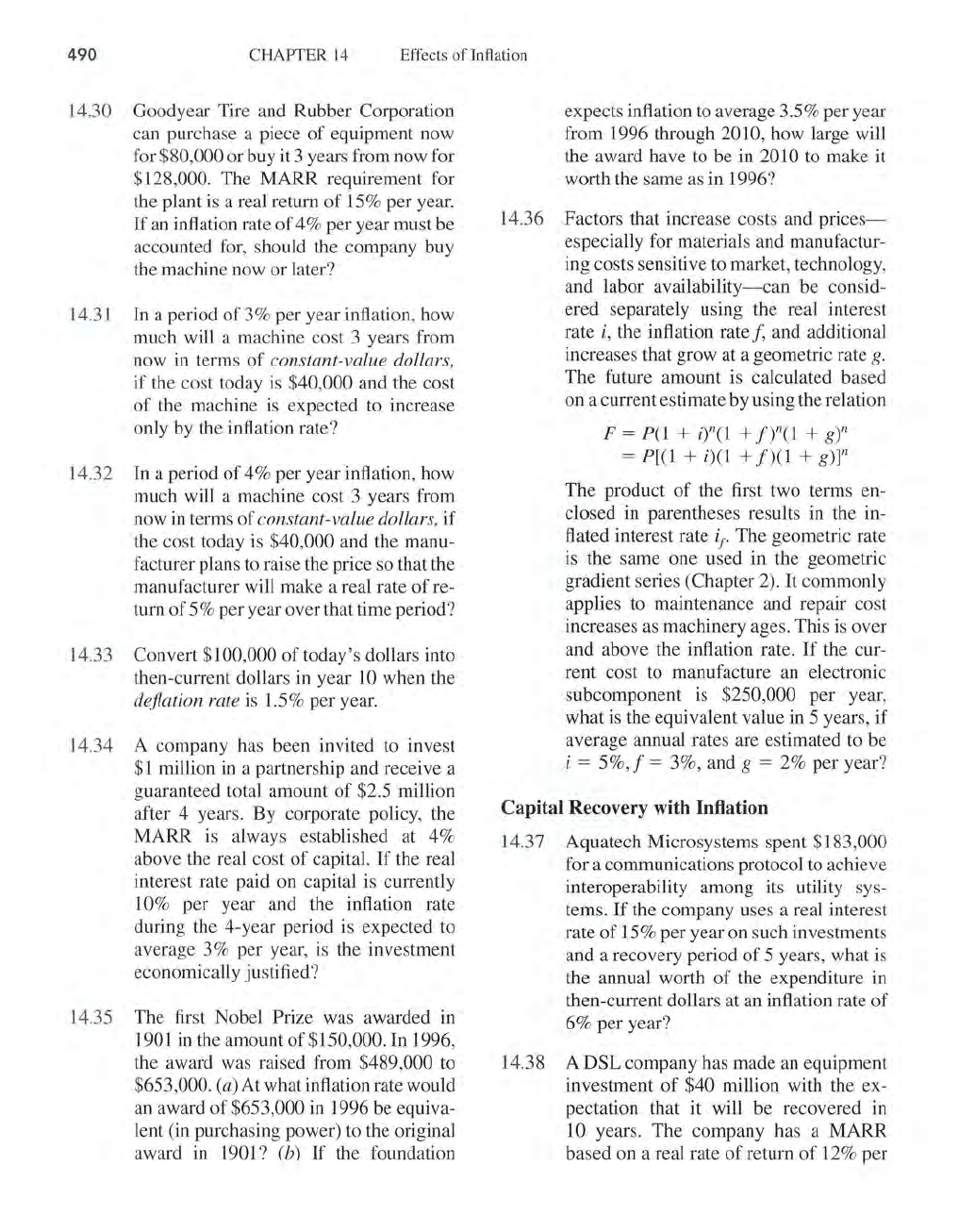
490
CHAPTER
14
Effects
of
Inflation
14.30 Goodyear Tire and Rubber Corporation
can purchase a piece
of
equipment now
for
$80,000 or buy it 3 years from now for
$128,000. The MARR requirement for
the plant is a real return
of
15% per year.
If
an inflation rate
of
4% per year must be
accounted for, should the company buy
the machine now or later?
14.31
In
a period
of
3% per year inflation, how
much will a machine cost 3 years from
now
in
terms
of
constant-value dollars,
if the cost today is
$40,000 and the cost
of
the machine is expected to increase
only
by
the inflation rate?
14.32 In a period
of
4% per year inflation, how
much will a machine cost 3 years from
now
in
terms
of
constant-value dollars,
if
the cost today
is
$40,000 and the manu-
facturer plans
to
raise the price so that the
manufacturer will make a real rate
of
re-
turn
of
5% per year over that time period?
14.33 Convert
$100,000
of
today's dollars into
then-current dollars in year
10 when the
deflation rate
is
1.5% per year.
14.34 A company has been invited
to
invest
$1
mjilion
in
a partnership and receive a
guaranteed total amount
of
$2.5 million
after 4 years. By corporate policy, the
MARR
is
always established at 4%
above the real cost
of
capital.
If
the real
interest rate paid on capital is currently
10% per year and the inflation rate
during the 4-year period is expected
to
average 3% per year, is the investment
economically justified?
14.35 The first Nobel Prize was awarded in
1901
in
the amount
of
$150,000. In 1996,
the award was raised from
$489,000
to
$653,000.
(a)At
what inflation rate would
an
award
of
$653,000
in
1996 be equiva-
lent (in purchasing power)
to
the original
award
in
1901? (b)
If
the foundation
expects inflation to average 3.5% per year
from 1996 through
2010, how large will
the award have
to
be in 2010 to make it
worth the same
as
in 1996?
14
.36 Factors that increase costs and
prices-
especially for materials and manufactur-
ing costs sensitive to market, technology,
and labor
availability-can
be consid-
ered separately using the real interest
rate
i,
the inflation rate f, and additional
increases that grow at a geometric rate
g.
The future amount is calculated based
on a current estimate by using the relation
F = P(1 + i)"(1 +
fr(1
+
gy
= P[(1 +
i)(l
+
f)(l
+ g)]"
The product
of
the first two terms en-
closed in parentheses results in the in-
flated interest rate
if. The geometric rate
is the same one used in the geometric
gradient series (Chapter 2).
It commonly
applies
to
maintenance and repair cost
increases
as
machinery ages. This is over
and above the inflation rate.
If
the cur-
rent cost
to
manufacture an electronic
subcomponent is
$250,000 per year,
what is the equivalent value in 5 years,
if
average annual rates are estimated to be
i = 5%, f = 3%, and g = 2% per year?
Capital Recovery with Inflation
14.37 Aquatech Microsystems spent $183,000
for a communications protocol to achieve
interoperability among its utility sys-
tems.
If
the company uses a real interest
rate
of
15% per year on such investments
and a recovery period
of
5 years, what is
the annual worth
of
the expenditure in
then-current dollars at an inflation rate
of
6% per year?
14.38
ADSL
company has made
an
equipment
investment
of
$40 million with the ex-
pectation that it will be recovered
in
10 years. The company has a MARR
based on a real rate
of
return
of
12% per
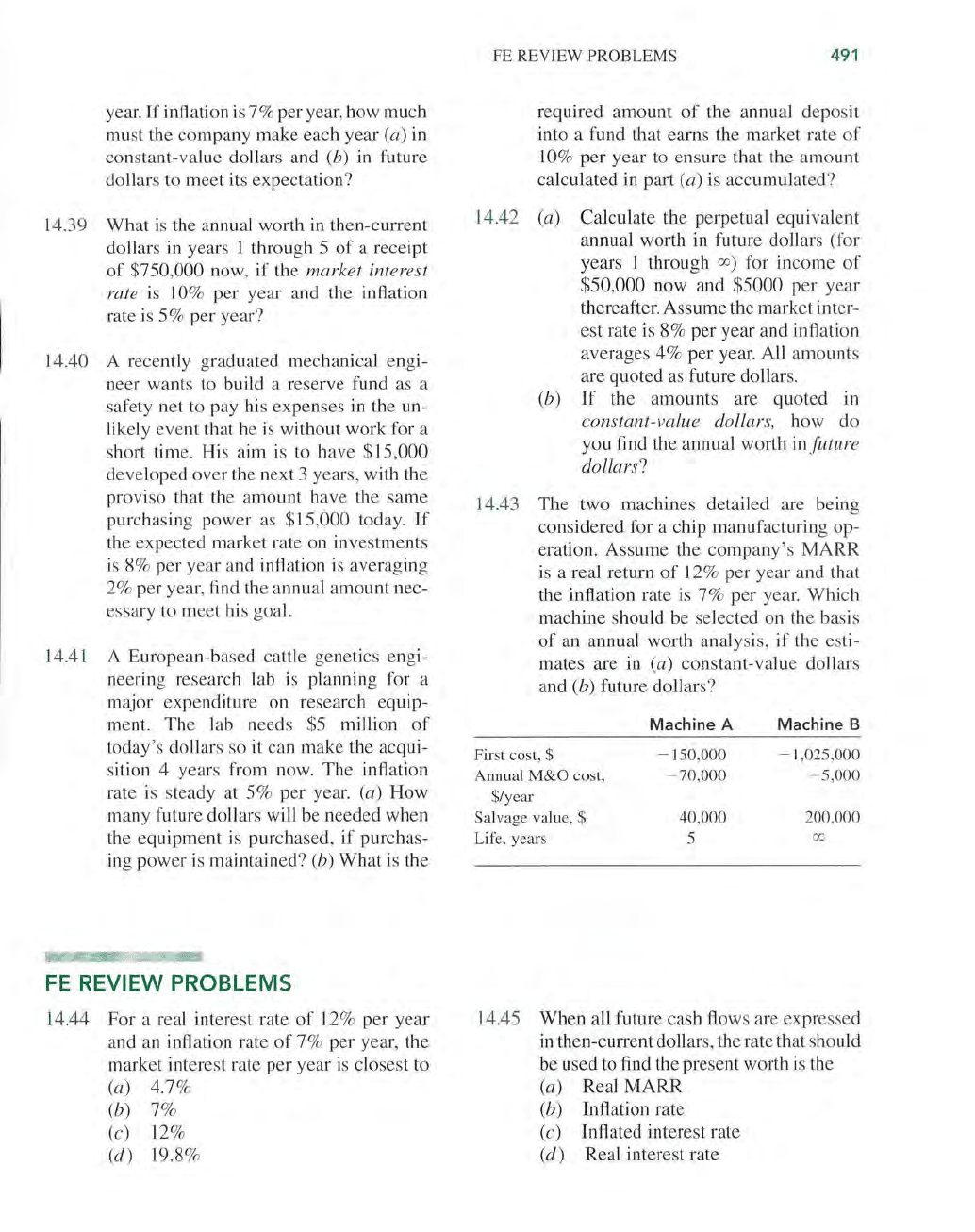
year.
If
inflationis 7% per year, how much
must the company make each year
(a)
in
constant-value dollars and
(b)
in
future
dollars to meet its expectation?
14.39 What is the annual worth in then-current
dollars in years 1 through 5
of
a receipt
of
$750,000 now,
if
the market interest
rate
is 10% per year and the inflation
rate
is 5% per year?
14.40 A recently graduated mechanical engi-
neer wants to build a reserve fund as a
safety net to pay his expenses in the un-
likely
event
that he is without work for a
short time. His aim is to have
$15,000
developed over the next 3 years, with the
proviso that the amount have the same
purchasing
power
as $15,000 today.
If
the expected market rate on investments
is 8% per year and inflation is averaging
2% per year, find the annual amount nec-
essary to meet his goal.
14.41 A European-based cattle genetics engi-
neering research lab is planning for a
major expenditure on research equip-
ment. The lab needs $5 million
of
today's dollars so
it
can make the acqui-
sition 4 years from now. The inflation
rate is steady at 5% per year.
(a) How
many future dollars will be needed when
the equipment is purchased,
if
purchas-
ing power
is
maintained?
(b)
What
is the
FE
REVIEW PROBLEMS
14.44
For
a real interest rate
of
12% per year
and an inflation rate
of
7% per year, the
market interest rate per year
is
closest to
(a) 4.7%
(b)
7%
(c) 12%
(d)
19.8%
FE
REVIEW PROBLEMS
491
required amount
of
the annual deposit
into a fund that earns the market rate
of
10%
per
year to ensure that the amount
calculated
in
part (a) is accumulated?
14.42 (a) Calculate the perpetual equivalent
annual worth in future dollars (for
years 1 through
CXl)
for income
of
$50,000 now and $5000 per year
thereafter. Assume the market inter-
est rate is 8% per year and inflation
averages 4% per year. All amounts
are quoted as future dollars.
(b)
If
the amounts are quoted
in
constant-value dollars, how do
you find the annual worth
infuture
dollars?
14.43 The two machines detailed are being
considered for a chip manufacturing op-
eration. Assume the
company's
MARR
is a real return
of
12% per year and that
the inflation rate is
7%
per year. Which
machine should
be
selected on the basis
of
an annual worth analysis,
if
the esti-
mates are in
(a) constant-value dollars
and
(b) future dollars?
Machine
A
Machine
B
First cost, $
~
150,000
~
1
,
025
,
000
Annual M&O cost,
~
70,000
~
5,000
$/year
Salvage value, $
40,000 200,000
Life, years
5
CXl
14.45 When all future cash flows are expressed
in then-current dollars, the rate that should
be used to find the present worth is the
(a)
Real
MARR
(b)
Inflation rate
( c) Inflated interest rate
(d)
Real interest rate
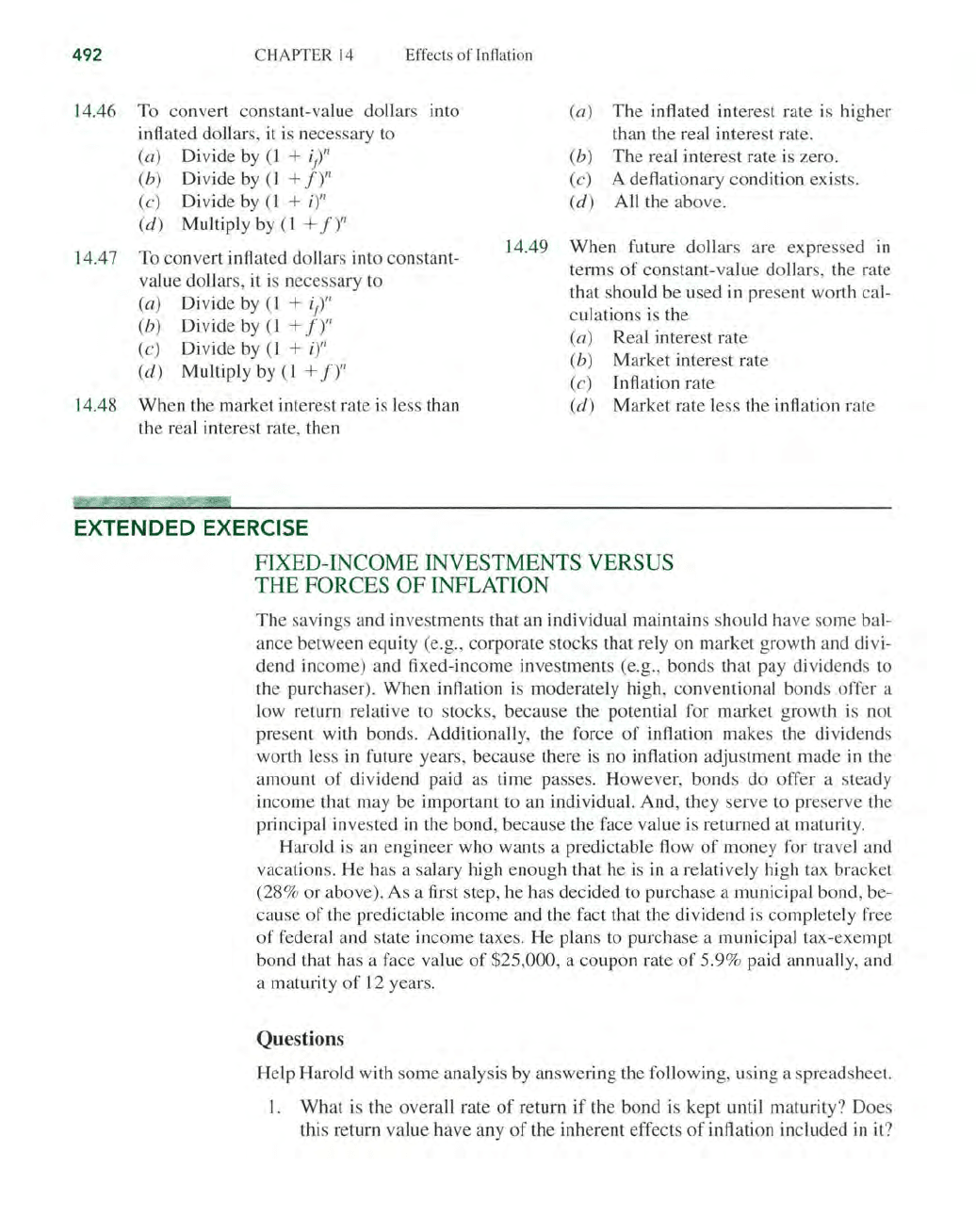
492
CHA
PT
ER
14
Effects
of
I
nfl
ation
14.46 To convert constant-va
lu
e do
ll
ars into
infl
ated dollars, it is necessary to
(0) The inflated interest rate is
hi
gh
er
than the real interest rate.
(a)
Divide by
(1
+ il '
(b) Divide by
(l
+
f)"
(c) Divide by
(1
+
i)"
(d) Multiply by (1 +
f)"
14.47 To convert inflated do
ll
ars into constant-
value dollar
s,
it is necessary to
(a) Divide by
(1
+ i
f
)1l
(b) Divide by
(l
+
f)"
(c) Divide by ( I + i)"
(d) Multiply by
(l
+
f)"
14.48 When the market interest rate is less than
the re
al
interest rate,
th
en
EXTENDED EXERCISE
(b) The real inter
es
t rate is zer
o.
(c) A deflationary condition exist
s.
(d) All the ab
ove
.
14.49 When future dollars are expressed in
terms
of
constant-value do
ll
ar
s,
the rate
that should
be
used in present worth cal-
c
ul
ations is the
(a) Real interest rate
(b)
Ma
rket interest rate
(c) Inflation rate
(d) Ma
rk
et rate less
th
e inflation rate
FIXED-INCOME INVESTMENTS VERSUS
THE FORCES
OF
INFLATION
The sav
in
gs and
in
vestments that an individual maintains should have some bal-
ance between equity (e.g., corporate stocks
th
at rely on market growth and
di
v
i-
dend
in
come) and
fix
ed-income
in
vestments (e.g., bonds that pay dividends to
th
e purchaser). When inflation is moderately high, conventional bonds offer a
l
ow
return rela
ti
ve
to stocks, because the potential for market
growt
h is not
present with bond
s.
Additiona
ll
y,
the force
of
inflation makes the dividends
worth less
in
future years,
be
cause there is no inflation adjustment made in the
amount
of
div
id
end paid as time passes. However, bonds do offer a steady
income
th
at may be important to an individual. And, they
se
rve to
pr
eserve
th
e
princ
ip
al invested
in
the bond, because the face value is returned at ma
tu
ri
ty.
Haro
ld
is an engineer who wants a predictable flow
of
money for travel and
vaca
ti
on
s.
He has a
sa
lary high enough that he is in a relatively high tax bracket
(28%
or
above). As a first step, he has decided to purchase a munic
ip
al bond, be-
cause of
th
e predictable income and the fact that the dividend
is
completely free
of
federal and state income taxe
s.
He plans to purchase a municipal tax-exempt
bond that has a face value
of
$25,000, a coupon rate
of
5.9% paid annually, and
a maturity of
12
years.
Questions
Help Haro
ld
with some analysis by an
swe
ring the follow
in
g, us
in
g a spreadshee
t.
I. What is the overall rate of return if the bond is kept until maturity? Does
this return value have any
of
the inherent effects of infla
ti
on
in
cluded
in
it
?
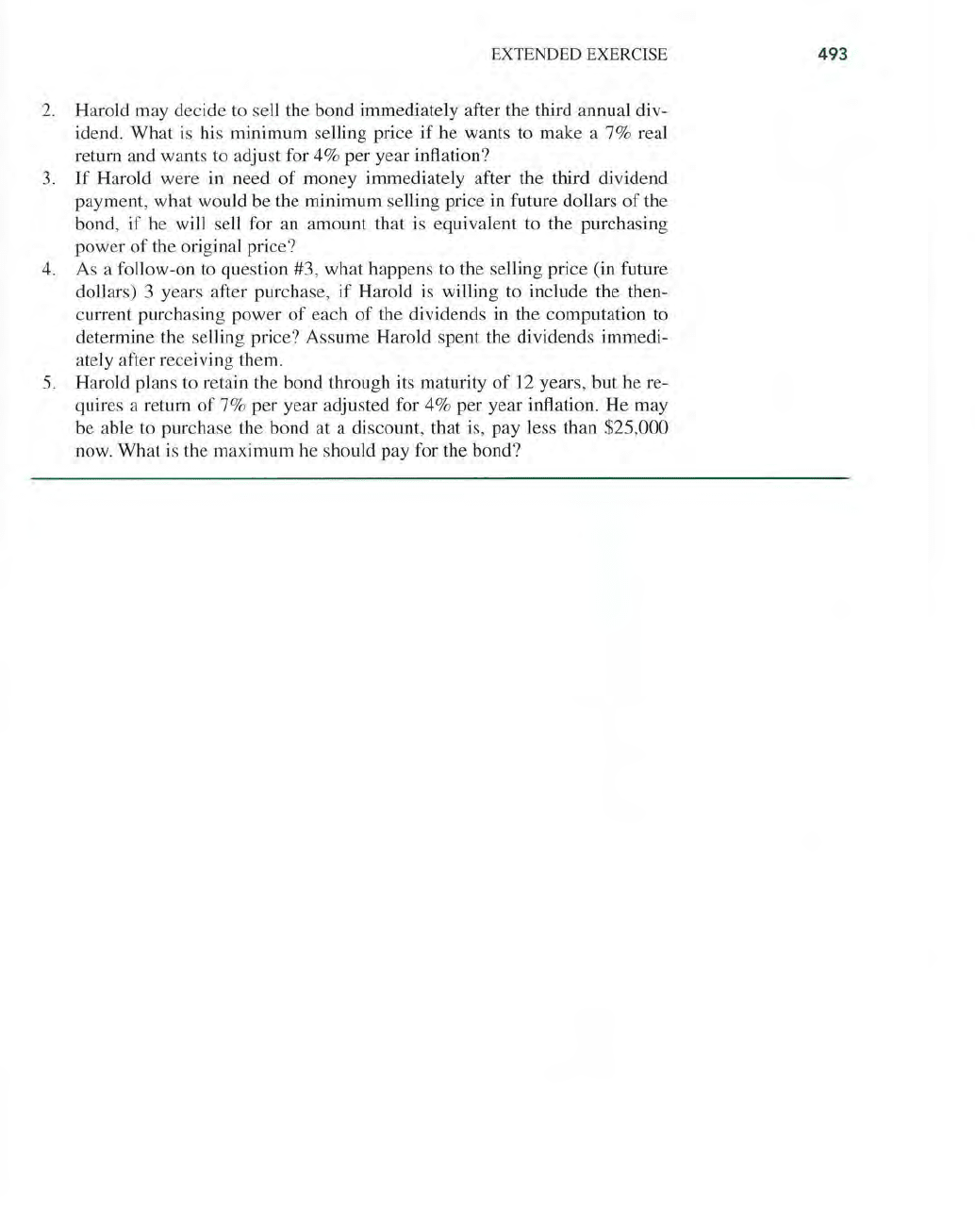
EXTENDED EXERCISE
2.
Harold may decide to sell the bond immediately after the third annual div-
idend. What
is
his minimum selling price
if
he wants to make a 7% real
return and wants to adjust for 4% per year inflation?
3.
If
Harold were in need
of
money immediately after the third dividend
payment, what would
be
the minimum selling price in future dollars
of
the
bond, if he will sell for an amount that
is
equivalent to the purchasing
power
of
the original price?
4. As a follow-on
to
question #3, what happens to the selling price (in future
dollars) 3 years after purchase,
if
Harold is willing to include the then-
current purchasing power
of
each
of
the dividends in the computation to
determine the selling price? Assume Harold spent the dividends immedi-
ately after receiving them.
5. Harold plans to retain the bond through its maturity
of
12 years, but he re-
quires a return
of
7% per year adjusted for 4% per year inflation. He may
be able
to
purchase the bond at a discount, that is, pay less than $25,000
now. What
is
the maximum he should pay for the bond?
493
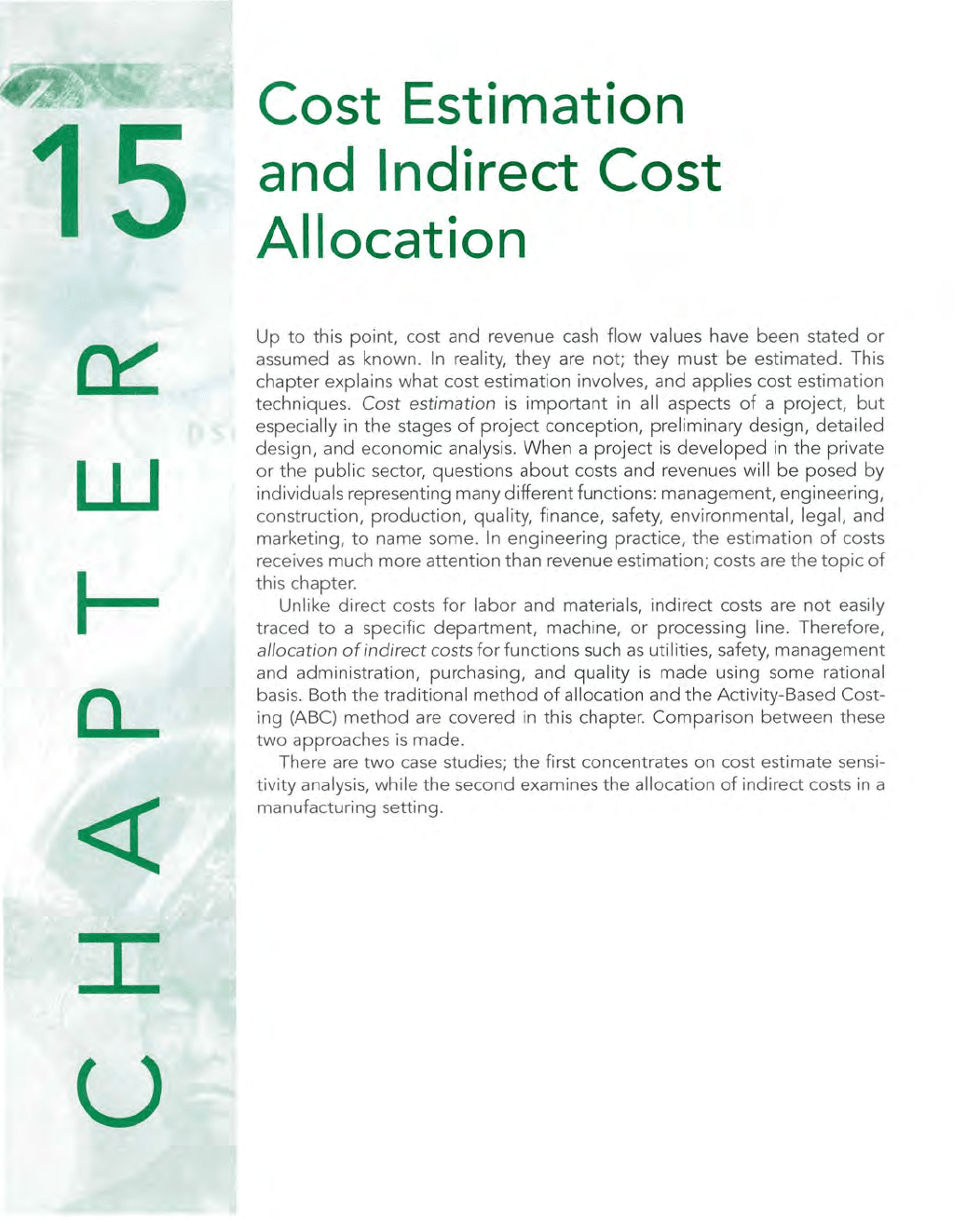
1
UJ
I-
I
u
Cost Estimation
and
Indirect Cost
Allocation
Up
to
this
point,
cost
and
revenue cash
flow
values have
been
stated
or
assumed
as
known.
In
reality,
they
are
not;
they
must
be
estimated.
This
chapter
explains
what
cost
estimation
involves,
and
applies
cost
estimation
techniques.
Cost
estimation is
important
in a
ll
aspects
of
a
project,
but
especially
in
the
stages
of
project
co
n
ception
,
pre
li
minary
design,
deta
il
ed
design,
and
econom
ic analysi
s.
When a
pro
j
ect
is
deve
l
oped
in
the
pr
i
vate
or
the
pub
li
c sector,
questions
abo
ut costs
and
revenues will
be
posed
by
individuals
representing
many
different
functions:
management
,
engineer
i
ng,
construct
ion,
production,
quality, finance, safety,
environmenta
l, legal,
and
marketing,
to
name
some.
In
engineering
practice,
the
estimation
of
costs
receives
much
more
attention
than
revenue
estimation;
costs are
the
topic
of
this
chapter.
Unlike
direct
costs
for
labor
and
materials,
indirect
costs are
not
easily
traced
to
a
specific
department,
machine,
or
processing
line. T
herefore,
allocation
of
indirect costs
for
functions
such
as
ut
il
it
ies, safety,
management
and
adm
inistr
ation,
purchasing,
and
qua
li
ty
is
made
using
some
rational
basis.
Both
the
trad
itional
method
of
a
ll
ocat
ion
and
the
Act
ivity-Based
Cost-
ing
(ABC)
method
are
covered
in
this
chapter.
Comparison
between
these
two
approaches
is
made.
There
are
two
case studies;
the
first
concentrates
on
cost
estimate
sensi-
tivity
analysis,
while
the
second
examines
the
allocation
of
indirect
costs in a
manufacturing
setting.
